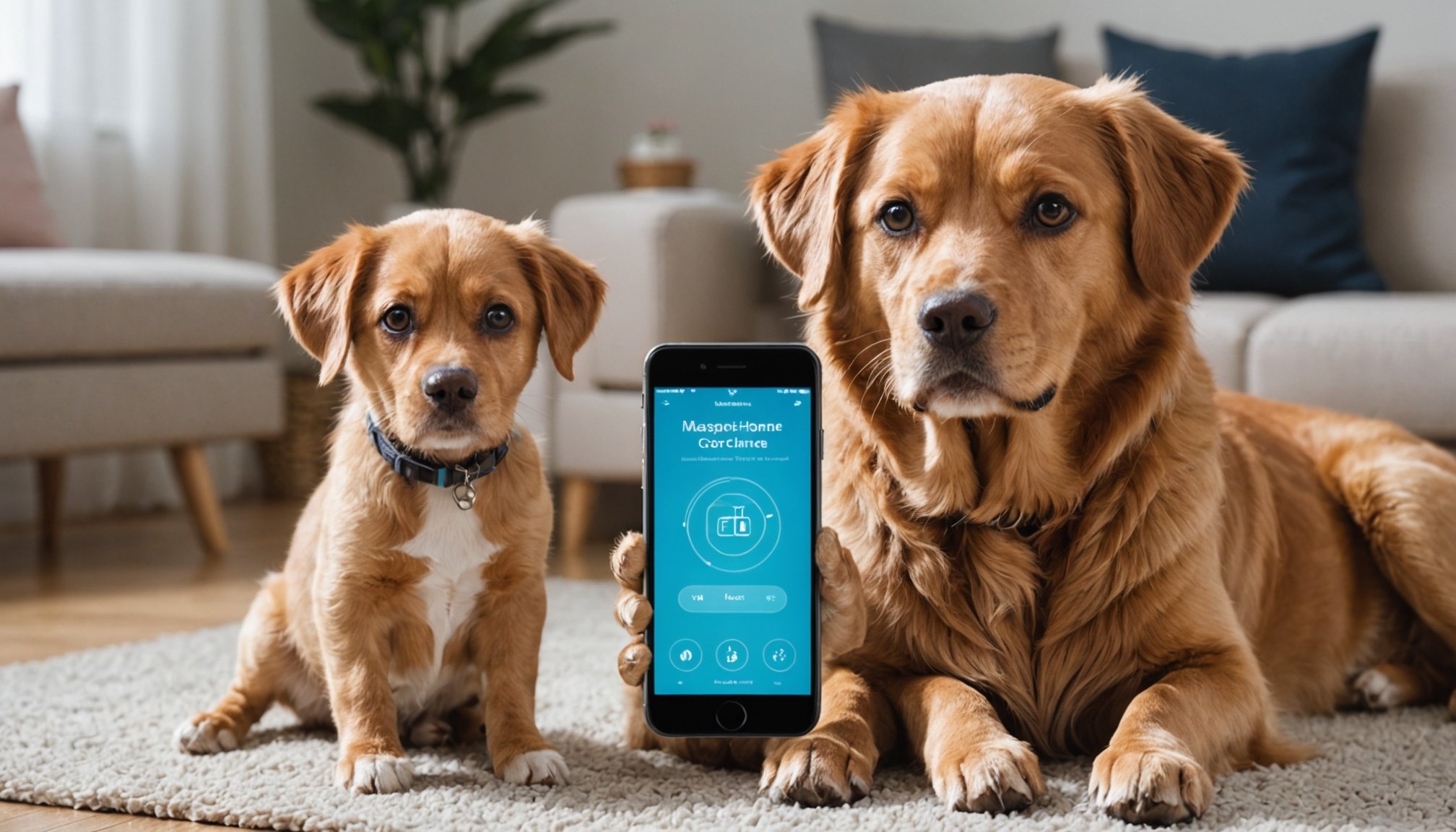Mastering Smart Home Pet Care: The Ultimate Guide to Smartphone Control
In the modern era, technology has revolutionized the way we live, work, and even care for our pets. Smart home devices have made it possible for pet owners to monitor, interact, and ensure the well-being of their pets remotely. This guide will delve into the world of smart home pet care, exploring how smartphone control can enhance your pet’s life and give you peace of mind.
Understanding Smart Home Technology
Before diving into the specifics of smart home pet care, it’s essential to understand the basics of smart home technology. Smart homes are equipped with devices that can be controlled and monitored via the internet, often through a smartphone app. These devices range from smart lighting and thermostats to security cameras and door locks.
Topic to read : Unlocking the Potential: Top Strategies for Transforming Your Smartphone into a Smart Home Hub
How Smart Home Devices Work
Smart home devices typically operate on a network, either through Wi-Fi or a dedicated hub. This allows them to communicate with each other and with your smartphone or voice assistant, like Amazon Alexa or Google Assistant. Here’s a breakdown of how some common smart home devices work:
- Smart Lighting: Smart lights can be turned on, off, or dimmed using a smartphone app. They can also be automated to follow a schedule or respond to motion detection.
- Security Cameras: These cameras allow you to monitor your home in real time, receive alerts for motion detection, and even communicate with your pets through two-way audio.
- Smart Locks: Smart locks can be locked or unlocked remotely, and some models even allow you to grant temporary access to dog walkers or pet sitters.
Setting Up Your Smart Home for Pet Care
Setting up a smart home tailored for pet care involves selecting the right devices and integrating them into a cohesive system.
In the same genre : Unlocking Your Smartphone: Top Techniques for Seamless Remote Desktop Access
Choosing the Best Devices for Pet Care
Here are some essential devices to consider:
- Smart Feeders: Automated feeders that can be controlled via an app to ensure your pet is fed on time, even when you’re away.
- Example: Petnet SmartFeeder, which allows you to schedule and adjust feeding portions remotely.
- Smart Water Bowls: Devices that monitor and maintain the freshness of your pet’s water.
- Example: Petnet SmartWater Bowl, which alerts you when the water level is low.
- Security Cameras with Two-Way Audio: Cameras that allow you to see and communicate with your pet in real time.
- Example: Nest Cam IQ, which offers high-resolution video and two-way audio.
Integrating Devices for Seamless Control
To get the most out of your smart home devices, integration is key. Here’s how you can integrate different devices for seamless control:
| Device | Integration Options | Benefits |
|
|-------------------------------------|
|
| Smart Feeders | Amazon Alexa, Google Assistant | Voice commands to feed your pet |
| Security Cameras| Nest Hub, Amazon Echo | Real-time monitoring and two-way audio |
| Smart Locks | Smart Home Hubs (e.g., Samsung SmartThings) | Automated access for pet sitters and dog walkers |
| Smart Lighting | Home Automation Systems (e.g., HomeKit) | Automated lighting schedules to simulate presence |
Automating Your Pet Care Routine
Automation is a powerful feature of smart home technology that can significantly simplify your pet care routine.
Scheduling and Automation
You can automate various tasks to ensure your pet’s needs are met consistently:
- Feeding Schedules: Set up automated feeding times using smart feeders.
- Example: “I use the Petnet SmartFeeder to ensure my dog is fed at the same time every day, even when I’m away at work,” says Sarah, a busy pet owner.
- Lighting and Temperature: Automate lighting and temperature adjustments to create a comfortable environment for your pet.
- Example: Smart thermostats like Nest can be programmed to maintain a comfortable temperature when you’re away.
Using Voice Commands for Convenience
Voice assistants like Alexa and Google Assistant make it easy to control your smart home devices with just a few voice commands.
- "Alexa, feed my dog."
- "Google, turn on the living room lights."
- "Alexa, lock the front door."
Enhancing Home Security for Your Pets
Home security is crucial when it comes to pet care, especially if you have pets that might escape or get into trouble.
Security Cameras and Motion Detection
Security cameras with motion detection can alert you to any unusual activity in your home. Here are some features to look for:
- Real-Time Monitoring: View your home in real time to check on your pets.
- Example: Ring Stick Up Cam offers real-time video and motion alerts.
- Two-Way Audio: Communicate with your pets or deter intruders.
- Example: Nest Cam IQ allows you to talk to your pets remotely.
Smart Locks and Access Control
Smart locks can help you manage who enters your home, ensuring your pets are safe.
- Temporary Access: Grant temporary access to pet sitters or dog walkers.
- Example: August Smart Lock allows you to create temporary access codes.
DIY Smart Home Projects for Pet Owners
If you’re on a budget or enjoy DIY projects, there are several ways to create smart home solutions for your pets without breaking the bank.
DIY Smart Feeding System
You can create a simple automated feeding system using an Arduino board and a servo motor.
- Materials Needed:
- Arduino Board
- Servo Motor
- Feeding Tray
- Power Source
- Steps:
- Program the Arduino board to control the servo motor.
- Attach the servo motor to the feeding tray.
- Set up a schedule using the Arduino code.
DIY Smart Lighting
You can automate your lighting using smart plugs and a DIY automation system.
- Materials Needed:
- Smart Plugs
- Smart Home Hub (e.g., Samsung SmartThings)
- Light Bulbs
- Steps:
- Plug your light bulbs into smart plugs.
- Connect the smart plugs to your smart home hub.
- Set up automated lighting schedules using the hub’s app.
Practical Tips and Advice for Smart Home Pet Care
Here are some practical tips to help you get the most out of your smart home pet care setup:
Monitoring Your Pet’s Health
- Use smart devices to monitor your pet’s health, such as smart collars that track activity and vital signs.
- Example: FitBark GPS, which tracks your dog’s activity and sleep patterns.
Creating a Safe Environment
- Ensure your home is pet-proofed by using smart devices to monitor and control potential hazards.
- Example: Smart plugs can be used to turn off appliances remotely if they are left on.
Training Your Pet
- Use smart devices to help train your pet, such as automated treat dispensers.
- Example: Furbo Interactive Dog Camera, which dispenses treats and allows two-way audio.
Mastering smart home pet care is about leveraging technology to enhance the lives of both you and your pets. By understanding how smart home devices work, setting up the right devices, automating routines, and enhancing home security, you can create a safe, comfortable, and engaging environment for your pets.
As pet owner John says, “Smart home devices have given me peace of mind. I can check on my dog, feed him, and even talk to him when I’m away. It’s like having an extra pair of eyes and hands to care for him.”
With the right tools and a bit of creativity, you can transform your home into a smart, pet-friendly haven that makes life easier and more enjoyable for everyone.











